by Brian Hioe
語言:
English
Photo Credit: Jesse Steele/WikiCommons
IF RECENT POLLING from the United Daily News have indicated a significant increase in Taiwanese identification, probably this should not come as a surprise to anyone who has been keeping track of politics in Taiwan in the last year. What is a surprise, seemingly indicative of the probable accuracy of this polling, is that the results of this poll come from the pro-China and pro-KMT leaning press of the United Daily News. And it is that those who have not been attentive to Taiwanese politics in the last year are still playing catch-up regarding these recent shifts in identification.
Shifts in Identification Not Just From the Young
SOME OBSERVATIONS bear pointing out from the results of UDN’s poll, which is available in English translation from Solidarity.tw. First, which is most obvious and really should not surprise anyone who paid attention to the Sunflower Movement or the role of young people in 2016 elections, is that the shift in identification is most evident in young people. Young people in Taiwan overwhelmingly do not identify as Chinese.
While we see a broader shift in identity, we also see a shift in identification among many members of older generations, for whom present events seem to have been an occasion to rethink their notions of identity. Very likely this has been prompted by the pro-China policies of the Ma administration and by the visible effects on Taiwan from China’s economic and political rise in the last ten years.
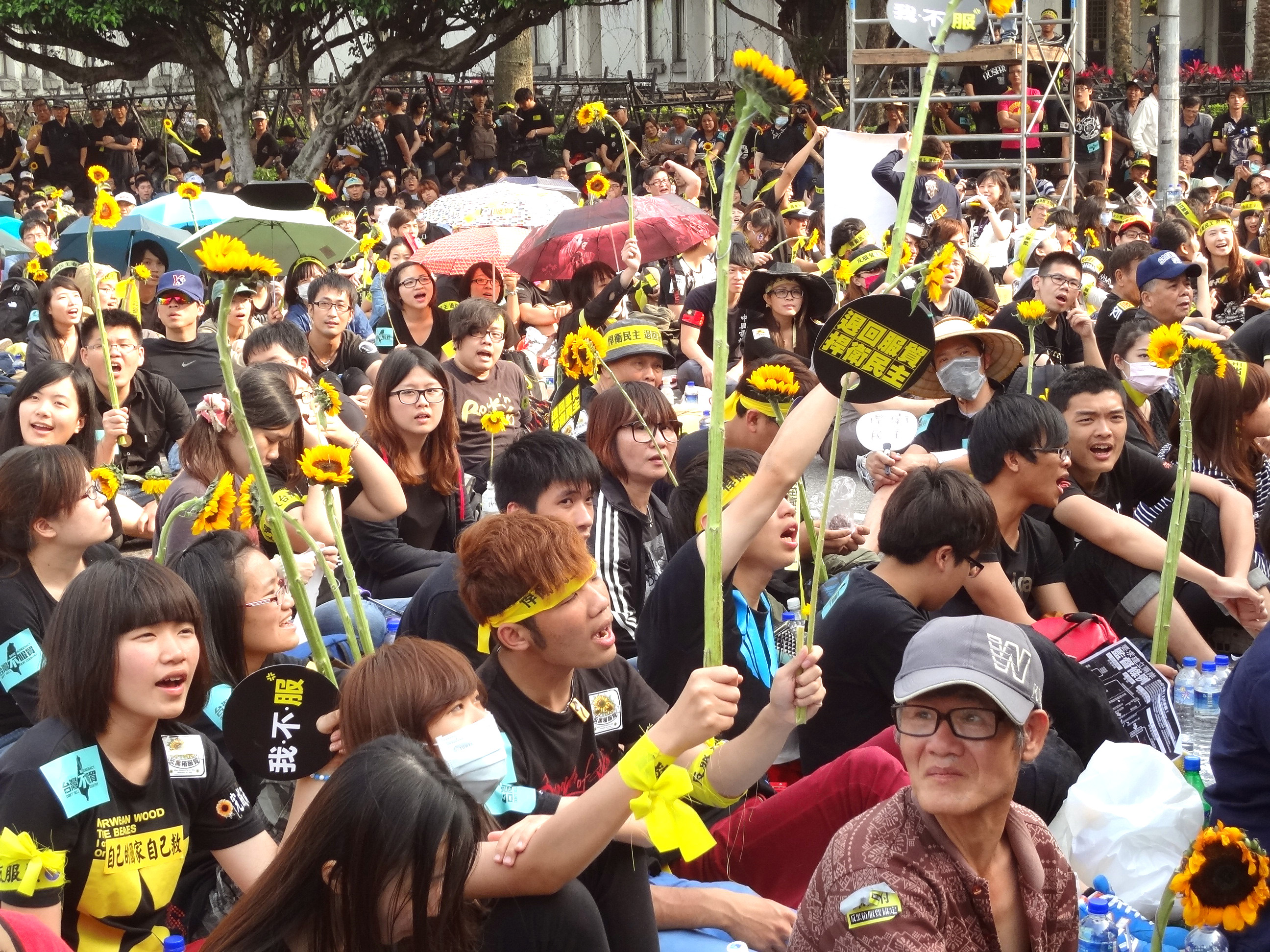 Demonstrators outside the Legislative Yuan during the Sunflower Movement. Photo credit: Taiwan People News
Demonstrators outside the Legislative Yuan during the Sunflower Movement. Photo credit: Taiwan People News
For many older waishengren (外省人) descended from the 10% or so of the population that came from China after 1949, for example, China was an imagined, idealized cultural homeland. But increasing contact with China itself in recent years may have led to a shift in views towards greater Taiwanese identification. This may be a result of many factors, ranging from witnessing the visible effects of the influx of Chinese tourist groups in Taiwan or travel to China itself, which sometimes leads not to a sense of cultural rediscovery but a sense of culture shock.
The increasingly authoritarian actions of the Chinese government under Xi Jinping also serve to make Taiwan’s relative freedoms as a product of its history of democracy stand out in contrast with China, which may also prompt their rethinking about identity. Another factor would be the Sunflower Movement in 2014. The actions of the Ma administration to put down young people during the movement led to shifts towards more negative views of the KMT’s pro-China policies for some.
Decline in Simultaneously Taiwanese and Chinese Identity
HOWEVER IT also bears pointing out that we not only see an increase in Taiwanese identification and a decline in Chinese identification, but also a decline in identification as simultaneously Taiwanese and Chinese, whether this is phrased as being “Taiwanese” (台灣人) and also “Chinese” (中國人) or the view that “Taiwanese” and “Chinese” are equivalent terms.
This is a point many western observers have failed to grasp. It is sometimes suggested that Taiwanese identity is not mutually exclusive with a Chinese sense of identity. In that sense, one cannot draw conclusions about the exclusivity between a Taiwanese sense of identity and Chinese one. And it is suggested that that the Taiwanese sense of identity may fade with time because a Taiwanese sense of identity does not necessarily mean a non-Chinese sense of identity—only that Taiwanese do not identify with the PRC or mainland China.
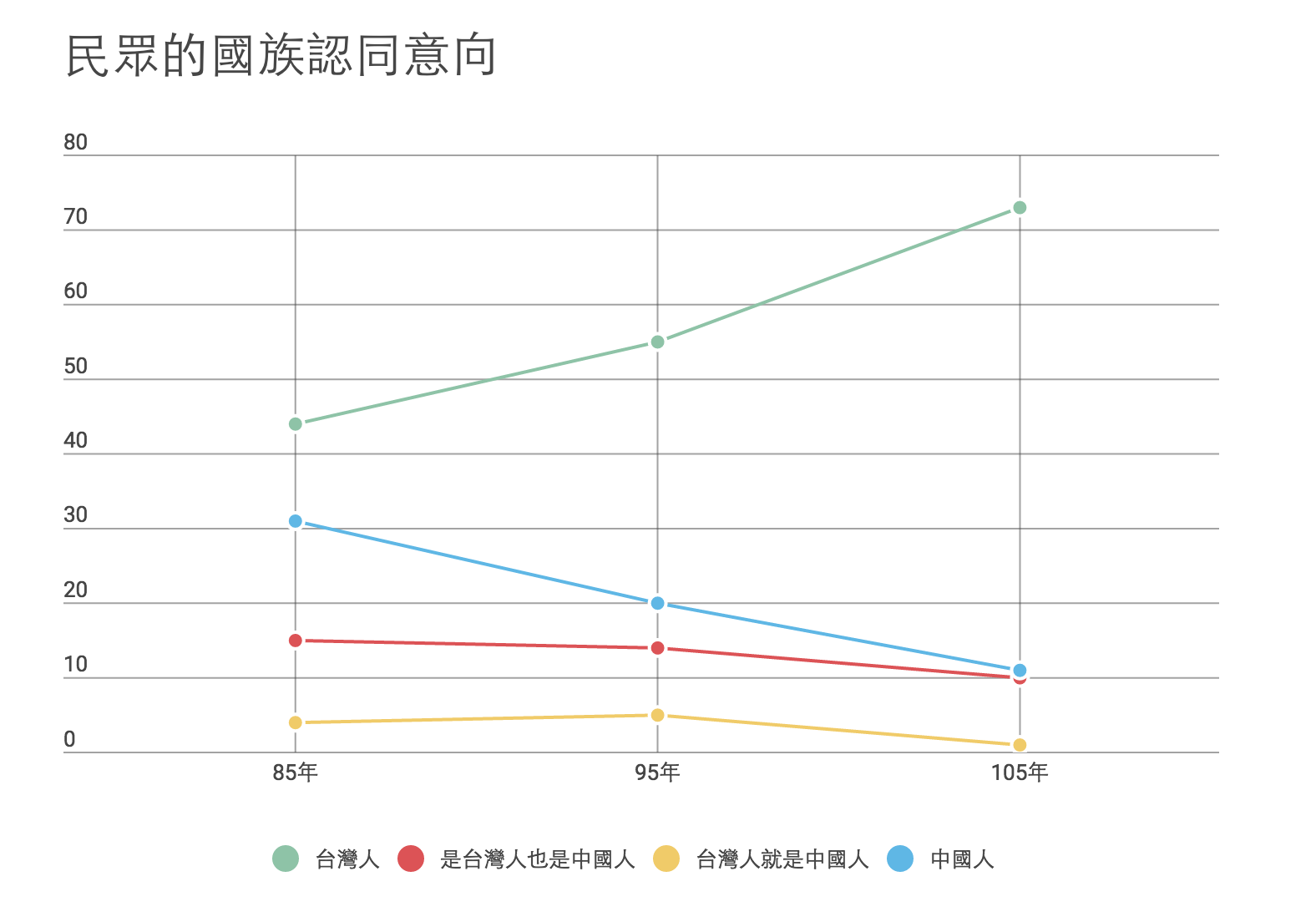 Polling results regarding identity from the United Daily News. Photo credit: United Daily News
Polling results regarding identity from the United Daily News. Photo credit: United Daily News
There remain points of ambiguity. The term huaren (華人) is one of ambiguous nuance, for example. Though not usually used within China, but rather in countries and territories with large “ethnically Chinese” populations such as Taiwan or Singapore, the term huaren refers to what is “ethnically Chinese” but not necessarily residents of China. During the Sunflower Movement, it was a frequently raised point that Taiwan was the only democratic huaren county where China and Singapore are not democracies, for example. Nevertheless, there is still pushback against the term as still being too close to Chinese identification or too synonymous with China.
But regardless of the valences of the term huaren, outside of immigrants and Taiwanese indigenous people, Taiwanese—whether waishengren (外省人) or benshengren (本省人)—are still largely ethnically Han (漢人). The majority ancestors of benshengren are, after all, still ethnic Han originally from China, just from a much earlier wave of migration than 1949. Does this mean, then, that Taiwanese are in some sense both Chinese and Taiwanese? So why then, do we see the decline in simultaneous Taiwanese and Chinese identification?
The Breakdown of the Claim to Be Simultaneously Taiwanese and Chinese
TO ANSWER this question, it bears pointing to the discursive manifestation of the claim to be simultaneously Chinese and Taiwanese in contemporary discourse about ethnicity. Few would deny that Taiwanese are majority ethnically Han. But western observers have failed to pay sufficient attention to who it is exactly that in the present is claiming to be simultaneously Taiwanese and Chinese and what their backgrounds are.
Namely, the claim to be simultaneously Taiwanese and Chinese largely is a very conservative one in the present, used largely by pro-unification KMT forces. We may raise Lee Teng-Hui’s original attempt to assert the notion of the “New Taiwanese” (新台灣人), as a form of identity which is simultaneously Taiwanese and Chinese, during his presidential administration in the 1990s. This was Lee’s attempt to resolve the racial and ethnic contradictions of Taiwan and to find a middle ground for solving the independence/unification issue which was a compromise measure. Lee was, of course, a benshengren who had risen to the presidency as a member of the KMT but secretly harbored pro-independence views.
In the hands of Lee, the notion of the “New Taiwanese” was an attempt to carve out a space for Taiwanese identity without proving disruptive of volatile ethnic tensions in Taiwan. But in the hands of the KMT of Ma Ying-Jeou, the concept of “New Taiwanese” became an attempt to preserve a sense of Chinese identification to facilitate the pro-unification aims of the KMT, while making enough of a gesture that the KMT would be seen as something as Taiwanese and not a foreign regime imposed from China.
In this sense, Ma Ying-Jeou’s claims of being “New Taiwanese” were very different from Lee Teng-Hui’s. It is his notion of “New Taiwanese,” rather than Lee’s which survives in the present. This is the meaning of the claim to be simultaneously Taiwanese and Chinese in present discourse, where this claim is largely used as a cipher for what is in the end Chinese identification and pro-unification sentiment and a claim advanced by the KMT for this agenda. So, then, can we understand the breakdown of the claim to be simultaneously Taiwanese and Chinese in the present and why Taiwanese have also rejected this sense of identity.
Remaining Questions For Taiwanese Identity
NEVERTHELESS IN the interests of being critical about identity, without reverting to atavistic or primordialist claims, we might raise some questions as to what it means to be Taiwanese and not Chinese. We may note, for example, that the majority of those polled in UDN’s poll favor preserving the status quo and not either unification or independence. If young people are a major factor behind the upwards swing in Taiwanese identification and there have been recent debates about “ROC independence” (華獨) versus “Taiwanese independence” (台獨), this is the third term in the debate that is referred to as “natural independence” (天然獨立).
Today’s young people largely experience Taiwan as an independent country separate from China and, if it is that Taiwan has de facto independence from China but lacks de jure independence, young people take Taiwan’s de facto independence for granted. Yet it remains a fundamental question as to whether Taiwan’s current state of de facto independence from China can forever last without attempts to secure de jure independence through pursuit of what is referred to as Taiwanese independence. This may be the weakness of “natural independence”.
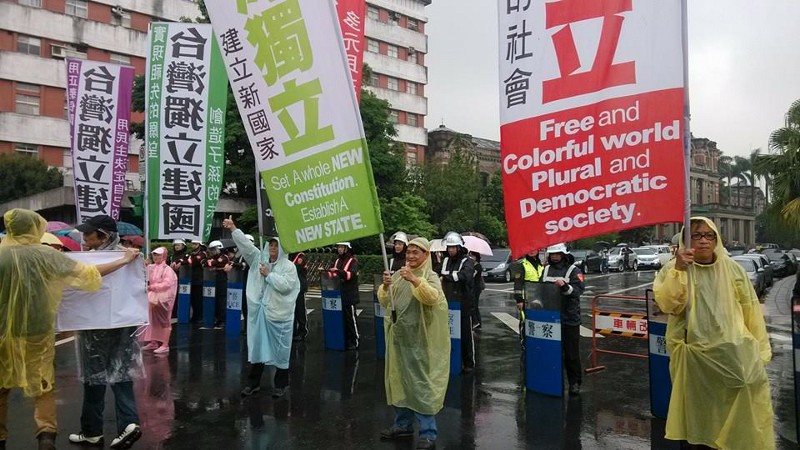 Taiwanese independence advocates. Photo credit: Brian Hioe
Taiwanese independence advocates. Photo credit: Brian Hioe
If these are heady questions which have still to be answered in Taiwanese history, we might also raise the question of exactly how a non-Chinese Taiwanese identity is defined? As with all forms of identity, a non-Chinese Taiwanese identity risks being only a form of “negative identity,” that is, a form of identity defined in opposition to another form of identity rather than a “positive identity” that truly has its own foundations. Where do Taiwanese draw the borders between themselves and Chinese, then?
In the past some have sought this in bloodline lineage, by pointing to how Taiwanese benshengren have some descent from Taiwanese indigenous peoples. Obviously, Chinese do not have such descent. But even if this is true, this remains problematic, because this actually negates the existence of Taiwanese indigenous peoples in no different a way than the KMT’s attempt to subsume Taiwan to China by appropriating them to what is in the end still a Han sense of identity.
Others have sought to depict Taiwan as distinguished from China on the basis of civilizational advancement. It is true that Taiwanese history splits very sharply from Chinese history in 1895, with Taiwan becoming a Japanese colony. But some have attempted to use this history of Japanese colonialism to suggest that Japanese colonialism, through modernizing Taiwan, made Taiwan civilizationally more advanced than China. This is used as an explanation for the many cases of Chinese tourists in Taiwan or elsewhere causing public incidents through their lack of social norms in, for example, in urinating or excreting in public.
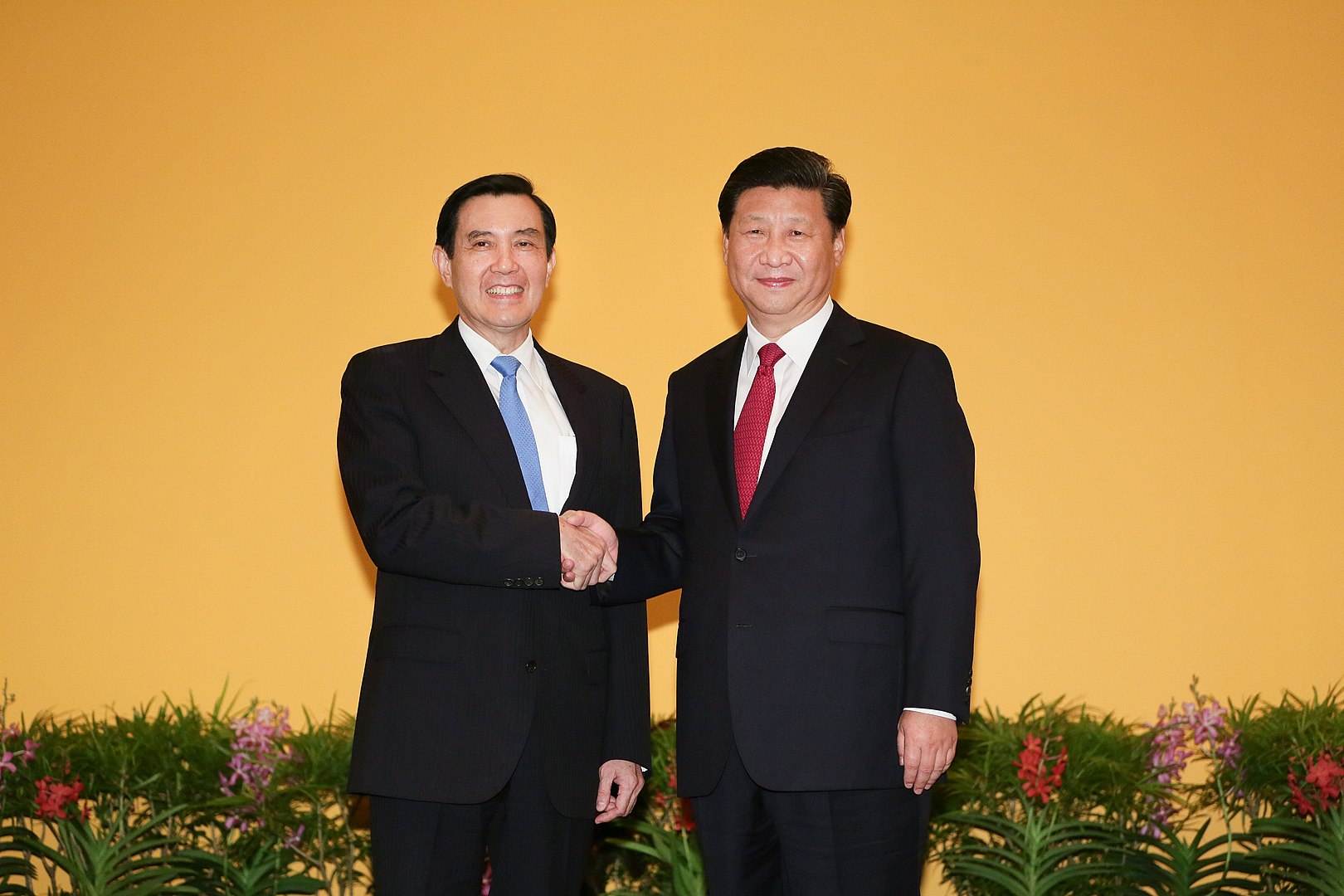 During their November meeting in Singapore, Taiwanese president Ma Ying-Jeou and Chinese president Xi Jinping referred to Taiwanese and Chinese alike as members of the Chinese race (中華民族) and as descendants of the Yellow Emperor. Photo credit: Presidential Office
During their November meeting in Singapore, Taiwanese president Ma Ying-Jeou and Chinese president Xi Jinping referred to Taiwanese and Chinese alike as members of the Chinese race (中華民族) and as descendants of the Yellow Emperor. Photo credit: Presidential Office
Yet this is very clearly an example of a “negative identity”, in which Taiwanese identity is defined solely in opposition to a Chinese sense of identity in terms which actually bespeak the attempt to avoid one’s own sense of inferiority. After all, is the only reason then, that Taiwanese are not Chinese because they have better western manners as a result of colonialism?
There are those who resort to wholesale historical revisionism by claiming that Taiwan was never part of China. It is true that Taiwan was never a part of China from some ahistorical notion of time immemorial, but only really became part of China during the Qing dynasty. Yet to seek to cut ties from China in this way by claiming Taiwan was never part of China is simply to propagate historical falsehood. And, again, there is also no getting around the fact that the majority Han ancestors of all non-indigenous Taiwanese are originally from China, even in the case of benshengren.
Conclusion: What Would It Take to Make the World Take Seriously Taiwanese Identity?
IF WESTERN OBSERVERS have failed to take seriously the claims of Taiwanese to not be Chinese, one may call attention to their general inability to distinguish between Taiwanese and Chinese. There are in fact substantial differences between Taiwanese and Chinese in regards to language, dress, body language, and custom, but many western observers have failed to notice this. Without even speaking of dialectal differences, there are substantial differences just between PRC Mandarin and Taiwanese Mandarin which many western observers fail to pick up on because of insufficient language skills, for example. One sometimes does get the feeling, however, that Chinese and Taiwanese alike are all simply just indistinguishable yellow people to many western observers.
These are differences in culture between Taiwanese and Chinese, which can be substantial at times, but which one may take note of without claiming that one culture is more civilized than another. Certainly, the visible sense of anxiety about one’s identity which is evidenced in the claim to draw boundaries between Chinese and Taiwanese on grounds of civilizational advancement actually just leads to the Taiwanese sense of identity being taken less seriously.
It certainly is today that Taiwanese do not identify as Chinese and it seems unlikely that the Taiwanese sense of identity as distinguished from a Chinese sense of identity will fade anytime soon. Against those who would urge caution about the potential dangers of Taiwanese nationalist identification, however, we may point to the fact that an exclusivist Taiwanese sense of identification that precludes a Chinese sense of identification actually has developed coextensively with what is a relatively broad and open sense of civic nationalism.
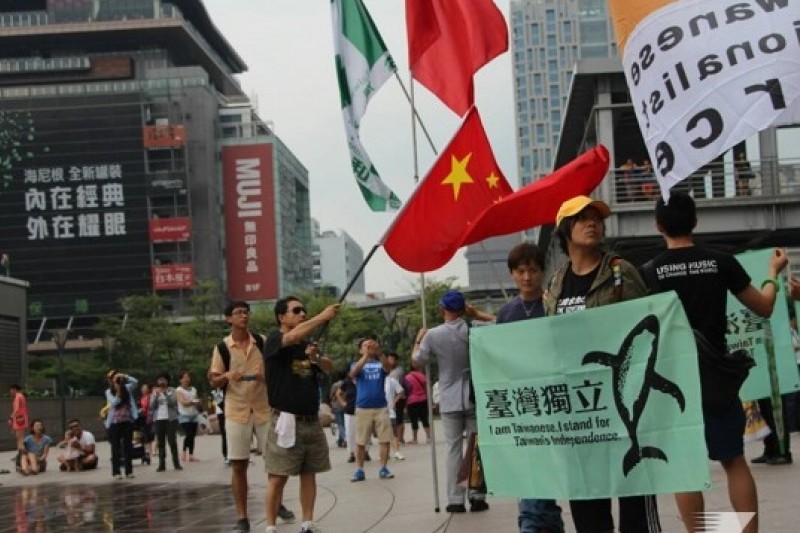 Clashing demonstrators outside of Taipei 101, with pro-PRC demonstrators waving Chinese flags and pro-independence demonstrators waving Taiwanese independence banners. Photo credit: 葉信菉/Storm Media
Clashing demonstrators outside of Taipei 101, with pro-PRC demonstrators waving Chinese flags and pro-independence demonstrators waving Taiwanese independence banners. Photo credit: 葉信菉/Storm Media
Although dissatisfaction with the influx of Chinese tourists has led to outbreaks of anti-Chinese sentiment, many Taiwanese simply view China as another country apart from theirs. In this sense, even when it is taken into account that China is Taiwan’s greatest existential threat, very often there is not a sense of grudge against Chinese themselves. Indeed, there were in fact Chinese participants in events such as the Sunflower Movement who were welcomed with open arms. We shall see if this continues to be the case in the future.
But it remains for further foundations for a Taiwanese sense of identity to be constructed as a form of “positive identity” rather one founded on negating other forms of identity. And if the world is to made to recognize the Taiwanese sense of identity as distinguished from a Chinese sense of identity, one needs to find ways to express the Taiwanese sense of identity as such a form of positive identity with solid grounds that do not resort to historical atavism.


 Demonstrators outside the Legislative Yuan during the Sunflower Movement. Photo credit: Taiwan People News
Demonstrators outside the Legislative Yuan during the Sunflower Movement. Photo credit: Taiwan People News Polling results regarding identity from the United Daily News. Photo credit: United Daily News
Polling results regarding identity from the United Daily News. Photo credit: United Daily News Taiwanese independence advocates. Photo credit: Brian Hioe
Taiwanese independence advocates. Photo credit: Brian Hioe Clashing demonstrators outside of Taipei 101, with pro-PRC demonstrators waving Chinese flags and pro-independence demonstrators waving Taiwanese independence banners. Photo credit: 葉信菉/Storm Media
Clashing demonstrators outside of Taipei 101, with pro-PRC demonstrators waving Chinese flags and pro-independence demonstrators waving Taiwanese independence banners. Photo credit: 葉信菉/Storm Media